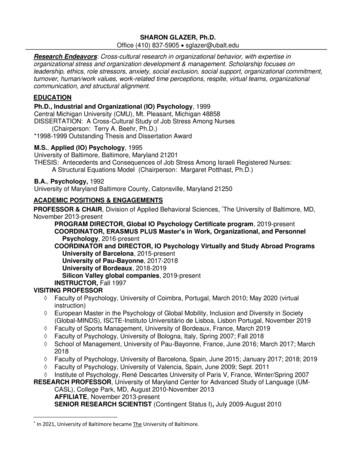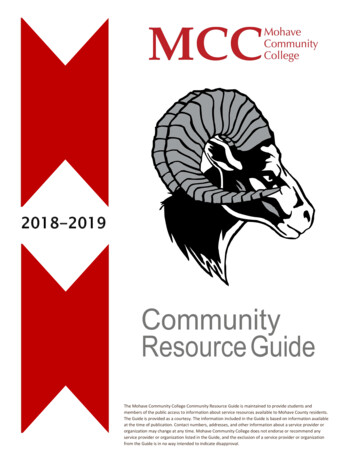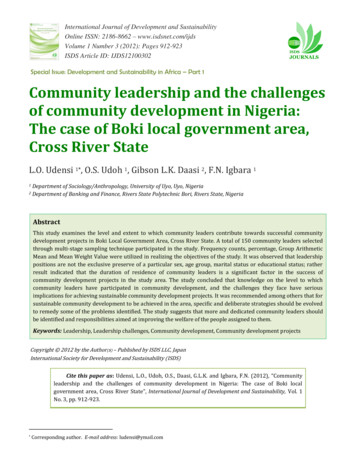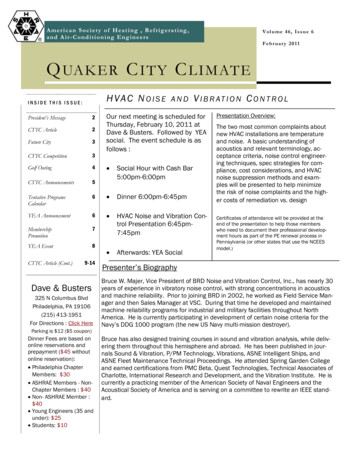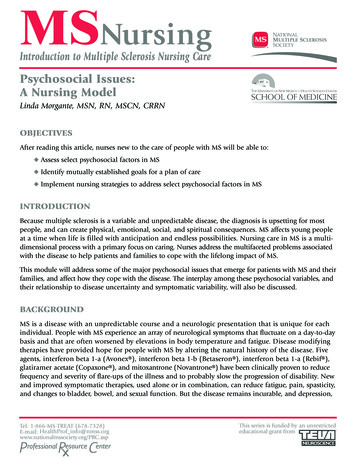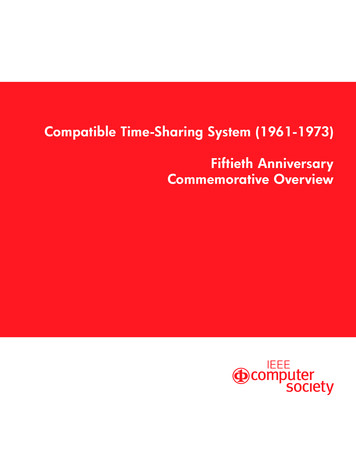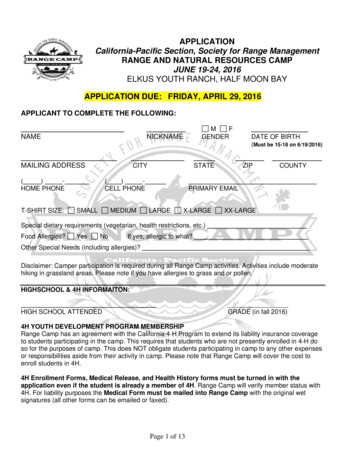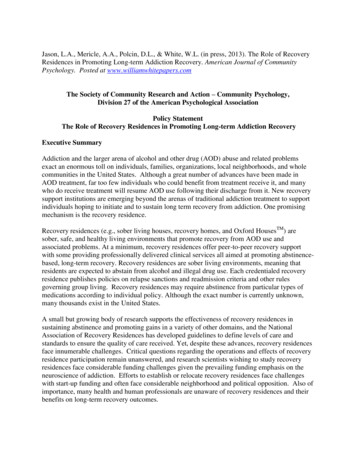
Transcription
Jason, L.A., Mericle, A.A., Polcin, D.L., & White, W.L. (in press, 2013). The Role of RecoveryResidences in Promoting Long-term Addiction Recovery. American Journal of CommunityPsychology. Posted at www.williamwhitepapers.comThe Society of Community Research and Action – Community Psychology,Division 27 of the American Psychological AssociationPolicy StatementThe Role of Recovery Residences in Promoting Long-term Addiction RecoveryExecutive SummaryAddiction and the larger arena of alcohol and other drug (AOD) abuse and related problemsexact an enormous toll on individuals, families, organizations, local neighborhoods, and wholecommunities in the United States. Although a great number of advances have been made inAOD treatment, far too few individuals who could benefit from treatment receive it, and manywho do receive treatment will resume AOD use following their discharge from it. New recoverysupport institutions are emerging beyond the arenas of traditional addiction treatment to supportindividuals hoping to initiate and to sustain long term recovery from addiction. One promisingmechanism is the recovery residence.Recovery residences (e.g., sober living houses, recovery homes, and Oxford HousesTM) aresober, safe, and healthy living environments that promote recovery from AOD use andassociated problems. At a minimum, recovery residences offer peer-to-peer recovery supportwith some providing professionally delivered clinical services all aimed at promoting abstinencebased, long-term recovery. Recovery residences are sober living environments, meaning thatresidents are expected to abstain from alcohol and illegal drug use. Each credentialed recoveryresidence publishes policies on relapse sanctions and readmission criteria and other rulesgoverning group living. Recovery residences may require abstinence from particular types ofmedications according to individual policy. Although the exact number is currently unknown,many thousands exist in the United States.A small but growing body of research supports the effectiveness of recovery residences insustaining abstinence and promoting gains in a variety of other domains, and the NationalAssociation of Recovery Residences has developed guidelines to define levels of care andstandards to ensure the quality of care received. Yet, despite these advances, recovery residencesface innumerable challenges. Critical questions regarding the operations and effects of recoveryresidence participation remain unanswered, and research scientists wishing to study recoveryresidences face considerable funding challenges given the prevailing funding emphasis on theneuroscience of addiction. Efforts to establish or relocate recovery residences face challengeswith start-up funding and often face considerable neighborhood and political opposition. Also ofimportance, many health and human professionals are unaware of recovery residences and theirbenefits on long-term recovery outcomes.
The Society of Community Research and Action (SCRA) has developed, with the executive,advocacy and research committees of the National Association of Recovery Residences (NARR),a policy statement on the value of recovery residences in the United States. This policystatement 1) describes the emergence and rapid growth of recovery residences as a new addictionrecovery support institution, 2) highlights research to date on the positive effects of participationin a recovery residence on long-term addiction recovery and related outcomes, 3) champions aresearch agenda that would address many unanswered questions related to such participation, 4)advocates social policies (laws, regulations and funding guidelines) in which recovery residencescan flourish, 5) supports programs of education and training to increase referrals to these newresources by health and human service professionals, and 6) promotes programs to educate localpolitical leaders and the public about the value of recovery residences for individuals, families,and communities in the United States.BackgroundAddiction and the larger arena of alcohol and other drug (AOD) and related problems exact anenormous toll on individuals, families, organizations, local neighborhoods and wholecommunities in the United States. Since the mid-twentieth century, an elaborate network ofprofessionally-directed addiction treatment programs has been funded to respond to theseproblems, but more than half of individuals treated in these institutions will resume AOD usefollowing their discharge from treatment—most often in the first 90 days following discharge.Assertive continuing care and support is not a routine component of addiction treatment in theUnited States and only a small percentage of persons treated participate in post-treatmentcontinuing care, which involves post-treatment monitoring and support. There are growing callsto shift acute care models of addiction treatment to models that emphasize sustained, posttreatment recovery management in order to elevate long-term recovery rates and enhance thequality of personal and family life in long-term recovery. Recovery management is aphilosophical framework for organizing addiction treatment services to provide long-termrecovery maintenance and quality-of-life enhancement for individuals and families affected bysevere substance use disorders.New recovery support institutions are emerging beyond the arenas of addiction treatment andrecovery mutual aid societies to achieve these goals. By providing a physical and social world torecover within, these new institutions (e.g., recovery residences, recovery schools, recoveryindustries, recovery ministries, recovery community centers, recovery cafes, etc.), mark a majormilestone in the history of recovery in the United States. One of the earliest to develop and oneof the most important of these new institutions is the recovery residence.Recovery residences (e.g., sober living houses, recovery homes, and Oxford HousesTM) aresober, safe, and healthy living environments that promote recovery from AOD use andassociated problems. The number of recovery residences in the U.S. has grown dramatically inthe past 25 years and have helped fill the void of community support between professionallydirected addiction treatment and peer-led recovery mutual aid societies. The purpose of arecovery residence is to provide a safe and healthy living environment to initiate and sustainrecovery—defined as abstinence from alcohol and other non-prescribed drug use andimprovement in one’s physical, mental, spiritual, and social wellbeing. Individuals build
resources while living in a recovery residence that will continue to support their recovery as theytransition to living independently and productively in the community. Although recovery iscommonly believed to refer to abstinence and a general sense of quality of life, recovery is by nomeans a simple construct that has uniform definition (i.e., some individuals define it asabstinence only from their primary drug; or as use of alcohol, but no drugs; or as no use of “harddrugs” but use of marijuana, or allow for use of “medical marijuana.”)There is growing consensus that recovery from severe substance use disorders involves threecritical components: sobriety, improvement in global (physical, emotional, relational, spiritual)health, and citizenship (positive community reintegration). Recovery residences are abstinencebased environments that provide mutual support for these three elements of recovery -in contrastto "wet housing" that allows residents to use alcohol or other drugs or "damp housing" thatdiscourages but does not exclude persons for using and that do not address these larger recoveryprocesses.A recent publication, A Primer on Recovery Residences in the United States (Jason, Mericle,Polcin, White, & the National Association of Recovery Residences, 2012), released by theNational Association of Recovery Residences based on a review of all materials published onrecovery residences to date found that: Although the exact number of recovery residences is currently unknown, there are manythousands of such residences operating in nearly every state across the nation;Recovery residences in the U.S. span from low to high service intensity and meet theneeds of residents at various stages of recovery (see figure below):
Most individuals in recovery residences have past or current involvement in addictiontreatment and participate in 12-Step or other recovery mutual aid organizations duringtheir time in the recovery residence.Participation in a recovery residence decreases in-treatment and post-treatment relapserates and significantly increases recovery outcomes (using such recovery measures assustained abstinence rates, improvements in global health and social functioning—e.g.,high rates of employment) at up to two-years of follow-up. Longer-term (5-10 years)follow-up studies have not yet been conducted.These benefits extend to women, women with children, African-Americans, and personswith co-occurring psychiatric diagnoses.These benefits are contingent on adequate lengths of stay (more than 6 months in level Irecovery residences) and a supportive community environment.The cost-effectiveness of recovery residences has not yet been rigorously investigated.However, some recovery residences, such as Oxford and California Sober Living Houses,are self-financed primarily through resident fees.Research to date generally finds that recovery residences do not negatively affectneighborhoods and may even provide benefits to the communities in which they arelocated.Some recovery residences are designed specifically for individuals with certain needs (e.g., cooccurring addiction and severe mental illness, veterans, mothers with children); however, somerecovery residences may not be equipped to adequately meet these residents’ needs. Individualswith specific service needs seeking recovery residences should ask the provider about how theseneeds can (or cannot) be addressed within a particular residence. It is still unclear if outcomesdiffer for people with co-occurring disorders (mental health, process addictions, major medicalissues such as Hepatitis C or HIV) living in recovery residences.Recovery residences are divided into Levels of Support based on the type as well as the intensityand duration of support that they offer. Services provided span from peer-to-peer recoverysupport (all recovery residences) to medical and counseling services (recovery residencesoffering higher levels of support). The National Association of Recovery Residence Standardsdefines minimum services for each Level of Support, but additional services may be provided ateach level. Section 5 of the National Association of Recovery Residences Standards, included inA Primer on Recovery Residences in the United States, details the minimum required serviceelements for each Level of Support. National Association of Recovery Residence-certifiedrecovery residences meet standards addressing safety from an administrative, operational,property, and good neighbors’ perspective. Recovery residences’ internal governance variesacross National Association of Recovery Residence Levels of Support. Forms of governancerange from democratically run by the residents to oversight by licensed professionals. Theregulation of recovery residences vary from state to state, local government to local government,and model to model. In general, states regulate professional services and local governmentsregulate health and safety standards. Both state and local government regulation must adhere tofederal laws and limits, such as the Americans with Disabilities Act and the Fair Housing Act.The National Association of Recovery Residences, established in 2011, currently representsapproximately 1,500 residences through its local organizational affiliates. The National
Association of Recovery Residences advocates for recovery residences and their residents at thenational and local levels. Members of the National Association of Recovery Residence maintainstandards for recovery residences of all kinds across the four National Association of RecoveryResidence Levels of Support, from Level 1 peer-operated residences to Level 4 residencesoffering a wide variety of treatment and recovery support services. Three additional recoveryresidence organizations exist with a national scope. The oldest is the Association of HalfwayHouse Alcoholism Programs, founded in 1958, and all are now affiliated with the NationalAssociation of Recovery Residences. The members of the Association of Halfway HouseAlcoholism Program include all of the National Association of Recovery Residences Levels ofSupport. The Association of Halfway House Alcoholism Program’s residences operate inaccordance with social model recovery principles. Oxford House Inc. was established in 1975and supports Oxford Houses internationally. Oxford Houses are National Association ofRecovery Residence Level 1, with each residence operated solely by the residents in accordancewith Oxford House guidelines. Oxford House Inc. supports and promotes its model for peeroperated recovery residences through training, technical assistance, and access to startupfinancing. They also advocate for recovery housing rights and provide legal support to OxfordHouses involved in disputes with cities and towns over their right to exist. TreatmentCommunities of America (formerly Therapeutic Communities of America) represents more than600 residential addiction treatment programs in the United States.Recovery residences face innumerable challenges in spite of their rapid growth and positivefindings on their effects on recovery outcomes. Critical questions regarding the operations andeffects of recovery residence participation remain unanswered, and research scientists wishing tostudy recovery residences face considerable funding challenges given the prevailing fundingemphasis on the neuroscience of addiction. Efforts to establish or relocate recovery residencesface challenges with start-up funding and often face considerable neighborhood and politicalopposition. Also of importance, many health and human professionals are unaware of recoveryresidences and their benefits on long-term recovery outcomes.RecommendationsIn light of these findings and circumstances, the Society of Community Research and Action(SCRA):1) Recommends that national, state, and local agencies support local networks of recoveryresidences. Specially, the SCRA calls upon: The Substance Abuse and Mental Health Services Administration to developfunding mechanisms to support the development, sustainment, and expansion ofrecovery support services specific to housing. The Department of Housing and Urban Development to develop fundingmechanisms to support the development, sustainment, and expansion of housingservices specifically for individuals in recovery from behavioral health disorders. The National Association of Recovery Residences to disseminate nationalstandards for recovery residences and to provide technical assistance for localorganizations to meet these standards as a means of improving the quality of localrecovery residences in the United States. This is of particular importance in order
to deal with a perception by some that relapse is common among residents inrecovery homes, they are often in unsafe neighborhoods, and many aredisorganized and even exploitive of residents.Single State Authorities on alcohol and other drug problems to establish loanfunds and other mechanisms that will support the development of recoveryresidences where the need for such resources has been established.The National Conference of State Legislatures, the United State Conference ofMayors, and the National League of Cities to develop policy documents and hostwebinars and conferences related to the issues surrounding the development ofsupportive housing for recovering individuals in local communities.2) Recommends enhanced funding for critical research related to recovery residences. TheSCRA calls upon: The National Institutes of Health (the National Institute on Alcohol Abuse andAlcoholism and the National Institute on Drug Abuse) to fund research related torecovery residences, including randomized clinical trials, long term outcomestudies, cost-effectiveness studies, and studies that isolate the most potentingredients of the recovery residence model of recovery support. We needrecovery outcome and cost savings data across the Levels of Support for variouspopulations (including co-occurring, re-entry with criminal mindsets, etc.)recovering from a diversity of chemical substances in comparison to or incombination with alternative approaches. Without published research andevidence-based practice designations, licensed professionals and policymakerswill continue to question the legitimacy of recovery residences and peer-basedrecovery. The Substance Abuse and Mental Health Administration’s Center for SubstanceAbuse Treatment to fund evaluations studies related to the integration of recoveryresidences and related recovery support institutions (e.g., recovery communitycenters, recovery schools, recovery industries, recovery ministries) within thenetwork of health care initiatives being launched by state and federal government.o Federal, state, and local funding sources to prioritize recovery residenceresearch studies that address 1) the effects of participation in a recoveryresidence on treatment retention/completion and post-treatment relapseand recovery rates as well as measures of global health and socialfunctioning—e.g., high rates of employment) at longer-term (5-10 years)intervals, 2) the degree of benefits living within recovery residencesextends to women, women with children, African-Americans, and personswith co-occurring psychiatric diagnoses, 3) the degree to which benefitsare contingent on adequate lengths of stay (more than 6 months in level Irecovery residences) and a supportive community environment, 4) therelative cost-effectiveness of recovery residences, and 5) the effects ofrecovery residences on neighborhoods and communities in which they arelocated. These are all high priority areas for research that is needed todevelop a more solid basis for our understanding of recovery residencesand their impacts on residents and communities.
National Association of Recovery Residences to increase their presence at keynational conferences (National Association of Addiction Treatment Providers, theAmerican Society of Addiction Medicine, and the American Association for theTreatment of Opioid Dependence) to engage the research community on the needfor research on recovery residences.Editors of addiction-related professional and trade journals to continue to publishstudies and reviews and special issues on the effects of participation in a recoveryresidence on long-term recovery outcomes.3) Recommends strategies to educate and train addiction treatment professionals and alliedhealth and human services professionals on the value of recovery homes. The SCRA callsupon: The APA to disseminate this policy document to all APA members as well as toother major related professional associations (e.g., the American PsychiatricAssociation, the National Association of Social Workers) with therecommendation that the latter develop and disseminate policy statements onrecovery residences and related recovery support institutions. College and university addiction studies programs, independent addictioncounselor training programs, and educational and training programs forpsychiatrists, psychologists, and social workers to integrate information onrecovery residences within their respective curricula. The national network of Addiction Technology Transfer Centers to disseminateinformation on recovery residences, including assertive referral procedures thatcan be used to access such resources and how recovery residences can beintegrated into
milestone in the history of recovery in the United States. One of the earliest to develop and one of the most important of these new institutions is the recovery residence. Recovery residences (e.g., sober living houses, recovery homes, and Oxford HousesTM) are sober, safe, and healthy living environments that promote recovery from AOD use andFile Size: 278KBPage Count: 9People also search forthe future of community psychologysociety of research administrators 2020scra community psychologycommunity development phd programsdoctorate in community development

